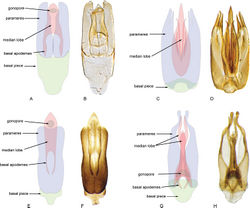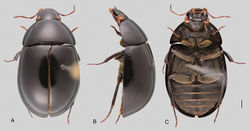Colossochares
| Notice: | This page is derived from the original publication listed below, whose author(s) should always be credited. Further contributors may edit and improve the content of this page and, consequently, need to be credited as well (see page history). Any assessment of factual correctness requires a careful review of the original article as well as of subsequent contributions.
If you are uncertain whether your planned contribution is correct or not, we suggest that you use the associated discussion page instead of editing the page directly. This page should be cited as follows (rationale):
Citation formats to copy and paste
BibTeX: @article{Girón2021ZooKeys1045, RIS/ Endnote: TY - JOUR Wikipedia/ Citizendium: <ref name="Girón2021ZooKeys1045">{{Citation See also the citation download page at the journal. |
Ordo: Coleoptera
Familia: Hydrophilidae
Name
Colossochares Girón & Short gen. nov. – Wikispecies link – ZooBank link – Pensoft Profile
- Helochares “Clade B”, Short et al. (2021)[1].
Gender
Masculine.
Type species
Helochares ellipticus d’Orchymont, 1933: 306; by present designation.
Etymology
From the Latin word colossus, meaning extremely large, in reference to the comparatively large and robust bodies of the members of the genus, combined with the ending chares, expressing affinity with Helochares. Masculine.
Diagnosis
Body length 8.5–14.0 mm. Body shape broadly oval in dorsal view, strongly and uniformly convex in lateral view (Fig. 26). Dorsal surfaces even and smooth, uniformly dark brown (nearly black) in coloration with reddish antennae, palps and tarsi; ground punctation extremely fine and shallow (Fig. 26A); ventral surfaces rather densely covered by rather long and fine golden setae (Fig. 26C). Eyes not emarginate, moderate in size, subquadrate in dorsal view, separated by nearly 4 × width of eye, projected from outline of head (Fig. 11I). Frons with large (and somewhat fused together) systematic punctures along inner margin of eye. Clypeus with anterior margin broadly roundly emarginate. Labrum fully exposed, medially convex (Fig. 11I). Antennae with nine antennomeres, with strongly asymmetric and round cupule. Maxillary palps slender, slightly longer than maximum width of head, with palpomere 4 0.7 × as long as palpomere 3 (Fig. 11I). Mentum medially broadly depressed, laterally punctate, mesally and anteriorly striate; sculpture of mentum ranging from shallow to strong. Pronotum evenly convex, and very smooth, with ground punctation very fine and shallow; systematic punctures of pronotum reduced to paired depressions near anterior margin and at midlength of lateral margins. Elytra without sutural striae, with margins slightly flared; serial punctures either absent or only visible along outer lateral area and posterior third of elytra; systematic punctures enlarged, broadly separated longitudinally, forming five rows mostly visible along outer lateral area and posterior third of elytra (Fig. 26A, B). Surface of prosternum flat to broadly convex, with anterior margin slightly projected anteriorly (Fig. 26C). Posterior elevation of mesoventrite with broad longitudinal elevation; anapleural sutures concave, anteriorly converging and separated by distance nearly 1/3 of anterior margin of mesepisternum. Metaventrite uniformly densely covered by with hydrofuge pubescence, medial surface elevated as platform. Protibiae with anterior row of spines extremely reduced to tiny and scanty, appressed denticles; apical spurs of protibiae large, outer nearly as thick and reaching apex of protarsomere 2. Metafemora with tibial grooves well-developed; metafemora with hydrofuge pubescence covering basal 4/5 of anterior surface (Fig. 26C). Metatarsomeres laterally compressed, metatarsomere 2 longer than 5, metatarsomere 5 nearly as long as 3 and 4 combined; all tarsomeres with rows spiniform setae covering ventral surface. Fifth abdominal ventrite with apex emarginate, with fringe of flat and stout setae. Aedeagus symmetrical, either trilobed (C. satoi; Hebauer 2003a[2]: fig. 1) or highly modified (Fig. 27A), with basal piece shorter than parameres; median lobe variable.
Differential diagnosis
Colossochares groups some of the largest acidocerines. Colossochares species are strongly and uniformly convex and highly polished, with enlarged systematic punctures on the head and elytra; systematic punctures on the pronotum are reduced to a pair of anterior and a pair of lateral depressions, not forming the usual antero-lateral semicircles that are common in acidocerines. Some members of Peltochares may exhibit similar coloration and general highly polished appearance to Colossochares (e.g., compare Fig. 1A vs. 1B); those Peltochares are always dorsoventrally flattened, generally slender, and the pronotum has systematic punctures forming antero-lateral semicircles. Other than general appearance, both genera are very similar to each other in details of the external morphology, except by the sculpture of the submentum, which is smooth in Colossochares and punctate or otherwise sculptured in Peltochares. In addition, the aedeagal form in Peltochares (spiked, Fig. 16C, D) is quite different from the forms present in Colossochares (trilobed or as in Fig. 27A).
Distribution
Afrotropical: Benin, Burkina Faso, Cameroon, Democratic Republic of the Congo, Ethiopia, Gabon, Ghana, Guinea, Ivory Coast, Liberia, Malawi, Nigeria, Republic of the Congo, Uganda; Fig. 4.
Natural history
Little is known about the biology of Colossochares, and no museum specimens we examined contained any habitat or collecting information. We have seen some light trap samples from Congo in which C. ellipticus is relatively common.
Larvae
The larvae of species of Colossochares remain unknown.
Taxonomic history
Given how large and distinctive Colossochares species are, it is remarkable that it has not been previously recognized as a separate genus, especially given how many other genera and subgenera have been described based on less striking features. The reason may have been due in part to an original identification error: Régimbart (1907[3]: 47) first gave a description for what is now Helochares ellipticus, but mistakenly thought they were conspecific with another already-described central African taxon, Hydrophilus ellipticus Fabricius. Régimbart (1907)[3], based on this incorrect interpretation of his specimens, further recognized that they were not allied with Hydrophilus and instead shared similarities with Helochares, so he transferred Fabricius’ species to Helochares, creating the combination Helochares ellipticus (Fabricius). Later, d’Orchymont (1933)[4] recognized Régimbart’s error and clarified the situation, confirming Helochares ellipticus as a valid species of Helochares, and also different from the original Hydrophilus ellipticus Fabricius.
Hebauer (2003) described Helochares satoi Hebauer and discussed its affinities with Helochares ellipticus. A specimen of Helochares ellipticus was included in the molecular phylogeny by Short et al. (2021)[1], where it was resolved as an early-diverging and isolated member of the Helochares group of genera. Given that it is not nested within Helochares, and it is morphologically distinct, the genus Colossochares is here established to house the two species: Colossochares ellipticus (d’Orchymont) comb. nov. and Colossochares satoi (Hebauer) comb. nov.
Remarks
Despite the external similarity between the two known species of Colossochares, the male genitalia are quite different from each other. This particularity is quite unusual in the subfamily given that, in general, each genus has a particular aedeagal type shared by all its species (though there are some known exceptions, e.g., Chasmogenus). The genitalia of C. satoi can be categorized as trilobed, whereas that of C. ellipticus is quite uniquely configured (Fig. 27B). More work is needed to confirm the close relationship of these two taxa.
Species examined
Specimens of Colossochares ellipticus (d’Orchymont) and female paratypes of C. satoi (Hebauer) were available for study.
Selected references
Régimbart 1907[3]: 47: description of Helochares ellipticus attributed to Fabricius; d’Orchymont 1933[4]: 306: clarification and reaffirmation of species name; Hebauer 2003: new species and discussion of affinities; Short et al. 2021[1]: phylogenetic placement.
Original Description
- Girón, J; Short, A; 2021: The Acidocerinae (Coleoptera, Hydrophilidae): taxonomy, classification, and catalog of species ZooKeys, 1045: 1-236. doi
Images
|
Other References
- ↑ 1.0 1.1 1.2 1.3 Short A, Girón J, Toussaint E (2021) Evolution and biogeography of acidocerine water scavenger beetles (Coleoptera: Hydrophilidae) shaped by Gondwanan vicariance and Cenozoic isolation of South America.Systematic Entomology46(2): 380–395. https://doi.org/10.1111/syen.12467
- ↑ Hebauer F (2003a) A new species of the genus Helochares (Coleoptera, Hydrophilidae) from Africa.Special Bulletin of the Japanese Society of Coleopterology6: 129–132.
- ↑ 3.0 3.1 3.2 Régimbart M (1907) Hydrophilides provenant du Voyage de M. L. Fea dans l’Afrique Occidentale. Annali del Museo civico di Storia naturale di Genova 3(3)[43]: 46–62. https://biodiversitylibrary.org/page/7931482
- ↑ 4.0 4.1 d’Orchymont A (1933) Contribution à l’étude des Palpicornia VIII.Bulletin et Annales de la Société entomologique de Belgique73: 271–314. [pl. 5.]

![Figure 2. Phylogeny of the Acidocerinae simplified from Short et al. (2021)[1], indicating the distribution, preferred habitat, and currently described number of species for each genus. For habitat, filled black circles indicate that at least some species of the genus are commonly found in this habitat; light grey circles indicate the genus has been found in this habitat, but is rare or not typical for the group; white circles indicate no species have been recorded for the genus in this habitat.](https://species-id.net/o/thumb.php?f=Zookeys-1045-001-g002.jpg&width=184)




